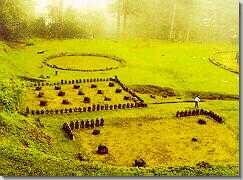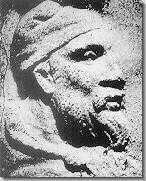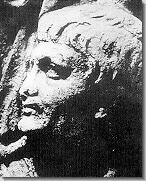
The Dacian stronghold
of Sarmisegetuza
|
|
Burebista (82 - around 44 BC), who
succeeded to unite the Geto-Dacian tribes for the first
time, founded a powerful kingdom that stretched, when the
Dacian sovereign offered to support Pompey against Caesar
(48 BC).
In the
1st century BC, as the Roman empire was expanding, the
Danube river became, along 1,500 Km., the border between
the Roman Empire and the Dacian world. |

King Decebal

Emperor Trajan
|
|
Dacia
was at the peak of its power under King Decebal (87-106 AD). After a first
confrontation during the reign of Domitian (87-89), two
extremely tough wars were necessary (101-102 and 105-106)
to the Roman empire, at the peak of its power under
Emperor Trajan (98-117) to defeat Decebal and turn most
of his kingdom into the Roman province called Dacia. Trajan’s
Column
erected in Rome and the Triumphal Monument at Adamclisi
(Dobrudja) tell the story of this military effort, which
was followed by a systematic and massive colonisation of
the new territories that were integrated into the empire.
The
Dacians remained, even after the new rule was
established, the main ethnic element in Dacia; the
province was subjected to a complex Romanization process,
its basic element being the staged but definitive
adoption of the Latin language.
|

Trajan's Column

The Triumphal Monument at Adamclisi
|
|
The
Romanians are today the only descendants of the Eastern
Roman stock; the Romanian language is one of the major
heirs of the Latin language, together with French,
Italian, Spanish. The
natives, be they of Roman or Daco-Roman descent,
continued their uninterrupted existence as farmers and
shepherds even after the withdrawal, under emperor
Aurelian (270-275), of the Roman army and administration,
which were moved south of the Danube. The ancestors of
the Romanians remained for several centuries in the
political, economic, religious and cultural sphere of
influence of the Roman Empire and Byzantine Empire (after
the Roman Empire split in 395 AD).
At
the time when the Daco-Roman ethno-cultural symbiosis was
achieved and finalised in the 6-7th centuries by the
formation of the Romanian people, in the 2-4th centuries,
the Daco-Romans adopted Christianity in a Latin garb.
Therefore, in the 6-7th centuries, when the formation
process of the Romanian people was done, this nation
emerged in history as a Christian one. This is why,
unlike the neighbouring nations, which have established
dates of Christianization (the Bulgarians - 865, the
Serbs - 874, the Poles-966, the eastern Slavs - 988, the
Hungarians - the year 1000), the Romanians do not have a
fixed date of Christianization, as they were the first
Christian nation in the region.
|
![[Cucuteni poterry]](cucuteni.jpg)
![[Thinker of Hamangia]](hamangia.jpg)




